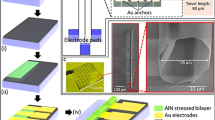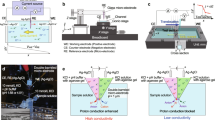Abstract
Surface science and molecular biology are often concerned with systems governed by fluid dynamics at the nanoscale, where different physical behaviour is expected1,2. With advances in nanofabrication techniques, the study of fluid dynamics around a nano-object or in a nano channel is now more accessible experimentally and has become an active field of research1,3,4,5. However, developing nanoscale probes that can act as flow sensors and that can be easily integrated remains difficult. Many studies demonstrate that carbon nanotubes (CNTs) have outstanding potential for nanoscale sensing, acting as strain6,7,8 or charge sensors in chemical9,10,11 and biological12,13,14,15 environments. Although nanotube flow sensors composed of bulk nanotubes have been demonstrated16, they are not readily miniaturized to nanoscale dimensions. Here we report that individual carbon nanotube transistors of ∼2 nm diameter, incorporated into microfluidic channels, locally sense the change in electrostatic potential induced by the flow of an ionic solution. We demonstrate that the nanotube conductance changes in response to the flow rate, functioning as a nanoscale flow sensor.
This is a preview of subscription content, access via your institution
Access options
Subscribe to this journal
Receive 12 print issues and online access
$259.00 per year
only $21.58 per issue
Buy this article
- Purchase on Springer Link
- Instant access to full article PDF
Prices may be subject to local taxes which are calculated during checkout




Similar content being viewed by others
References
Eijkel, J. C. T. & van den Berg, A. Nanofluidics: what is it and what can we expect from it? Microfluid. Nanofluid. 1, 249–267 (2005).
Israelachvilli, J. N., McGuiggan, P. M. & Homola, A. M. Dynamic properties of molecularly thin liquid films. Science 240, 189–191 (1988).
van der Heyden, F. H. J., Stein, D. & Dekker, C. Streaming currents in a single nanofluidic channel. Phys. Rev. Lett. 95, 116104 (2005).
Li, J. et al. Ion-beam sculpting at nanometre length scales. Nature 412, 166–169 (2001).
Han, J. & Craighead, H. G. Separation of long DNA molecules in a microfabricated entropic trap array. Science 288, 1026–1029 (2000).
Cao, J., Wang, Q. & Dai, H. J. Electromechanical properties of metallic, quasimetallic, and semiconducting carbon nanotubes under stretching. Phys. Rev. Lett. 90, 157601 (2003).
Minot, E. D. et al. Tuning carbon nanotube band gaps with strain. Phys. Rev. Lett. 90, 156401 (2003).
Yang, L. & Han, J. Electronic structure of deformed carbon nanotubes. Phys. Rev. Lett. 85, 154–157 (2000).
Kong, J. et al. Nanotube molecular wires as chemical sensors. Science 287, 622–625 (2000).
Staii, C., Johnson, A. T., Chen, M. & Gelperin, A. DNA-decorated carbon nanotubes for chemical sensing. Nano Lett. 5, 1774–1778 (2005).
Bradley, K., Gabriel, J. C. P., Briman, M., Star, A. & Gruner, G. Charge transfer from ammonia physisorbed on nanotubes. Phys. Rev. Lett. 91, 218301 (2003).
Bradley, K., Briman, M., Star, A. & Gruner, G. Charge transfer from adsorbed proteins. Nano Lett. 4, 253–256 (2004).
Boussaad, S., Tao, N. J., Zhang, R., Hopson, T. & Nagahara, L. A. In situ detection of cytochrome c adsorption with single walled carbon nanotube device. Chem. Commun. 13, 1502–1503 (2003).
Besteman, K., Lee, J. O., Wiertz, F. G. M., Heering, H. A. & Dekker, C. Enzyme-coated carbon nanotubes as single-molecule biosensors. Nano Lett. 3, 727–730 (2003).
Gao, M., Dai, L. & Wallace, G. G. Glucose sensors based on glucose-oxidase-containing polypyrrole/aligned carbon nanotube coaxial nanowire electrodes. Synthetic Met. 137, 1393–1394 (2003).
Ghosh, S., Sood, A. K. & Kumar, N. Carbon nanotube flow sensors. Science 299, 1042–1044 (2003).
Larrimore, L., Nad, S., Zhou, X., Abruna, H. & McEuen, P. L. Probing electrostatic potentials in solution with carbon nanotube transistors. Nano Lett. 6, 1329–1333 (2006).
Heller, I. et al. Individual single-walled carbon nanotubes as nanoelectrodes for electrochemistry. Nano Lett. 5, 137–142 (2005).
Campbell, J. K., Sun, L. & Crooks, R. M. Electrochemistry using single carbon nanotubes. J. Am. Chem. Soc. 121, 3779–3780 (1999).
Kruger, M., Buitelaar, M. R., Nussbaumer, T., Schonenberger, C. & Forro, L. Electrochemical carbon nanotube field-effect transistor. Appl. Phys. Lett. 78, 1291–1293 (2001).
Rosenblatt, S. et al. High performance electrolyte gated carbon nanotube transistors. Nano Lett. 2, 869–872 (2002).
Kirby, B. J. & Hasselbrink, E. F. Zeta potential of microfluidic substrates: 1. Theory, experimental techniques, and effects on separations. Electrophoresis 25, 187–202 (2004).
Sze, A., Erickson, D., Ren, L. & Li, D. Zeta-potential measurement using the Smoluchowski equation and the slope of the current–time relationshp in electroosmotic flow. J. Colloid Interface Sci. 261, 402–410 (2003).
Kim, D.-K., Majumdar, A. & Kim, S. J. Electrokinetic flow meter. Sensor Actuat. A-Phys. (2006).
Kral, P. & Shapiro, M. Nanotube electron drag in flowing liquids. Phys. Rev. Lett. 86, 131–134 (2001).
Hunter, R. J. Foundations of Colloid Science (Oxford Univ. Press, New York, 2001).
Ishigami, M. et al. Hooge's constant for carbon nanotube field effect transistors. Appl. Phys. Lett. 88, 203116 (2006).
Kong, J., Soh, H.T., Cassell, A.M., Quate, C.F. & Dai, H. Synthesis of individual single-walled carbon nanotubes on patterned silicon wafers. Nature 395, 878–881 (1998).
Mann, D., Javey, A., Kong, J., Wang, Q. & Dai, H. J. Ballistic transport in metallic nanotubes with reliable Pd ohmic contacts. Nano Lett. 3, 1541–1544 (2003).
Duffy, D. C., McDonald, J. C., Schueller, O. J. A. & Whitesides, G. M. Rapid prototyping of microfluidic system poly(dimethylsiloxane). Anal. Chem. 70, 4974–4984 (1998).
Acknowledgements
The authors wish to thank the Micro/Nano Fabrication Laboratory at Caltech where the sample fabrication was performed. This work was sponsored by Schlumberger. The work in Lausanne was supported by the Swiss NSF and its NCCR ‘Nanoscale Science’.
Author information
Authors and Affiliations
Contributions
B.B., J.W. and M.B. conceived and designed the experiments. B.B. and J.W. performed the experiments. B.B., J.W. and M.B. analysed the data. C.M. and L.F. contributed materials (multiwalled nanotubes). B.B., J.W. and M.B. co-wrote the paper. All authors discussed the results and commented on the manuscript.
Corresponding author
Ethics declarations
Competing interests
The authors declare no competing financial interests.
Rights and permissions
About this article
Cite this article
Bourlon, B., Wong, J., Mikó, C. et al. A nanoscale probe for fluidic and ionic transport. Nature Nanotech 2, 104–107 (2007). https://doi.org/10.1038/nnano.2006.211
Received:
Accepted:
Published:
Issue Date:
DOI: https://doi.org/10.1038/nnano.2006.211
This article is cited by
-
Flow-sensory contact electrification of graphene
Nature Communications (2021)
-
Carbon nanotubes in microfluidic lab-on-a-chip technology: current trends and future perspectives
Microfluidics and Nanofluidics (2017)
-
Multifunctional hydrogel nano-probes for atomic force microscopy
Nature Communications (2016)
-
Molecular dynamics simulation of nanoscale liquid flows
Microfluidics and Nanofluidics (2010)
-
Review: carbon nanotube for microfluidic lab-on-a-chip application
International Journal of Material Forming (2008)



